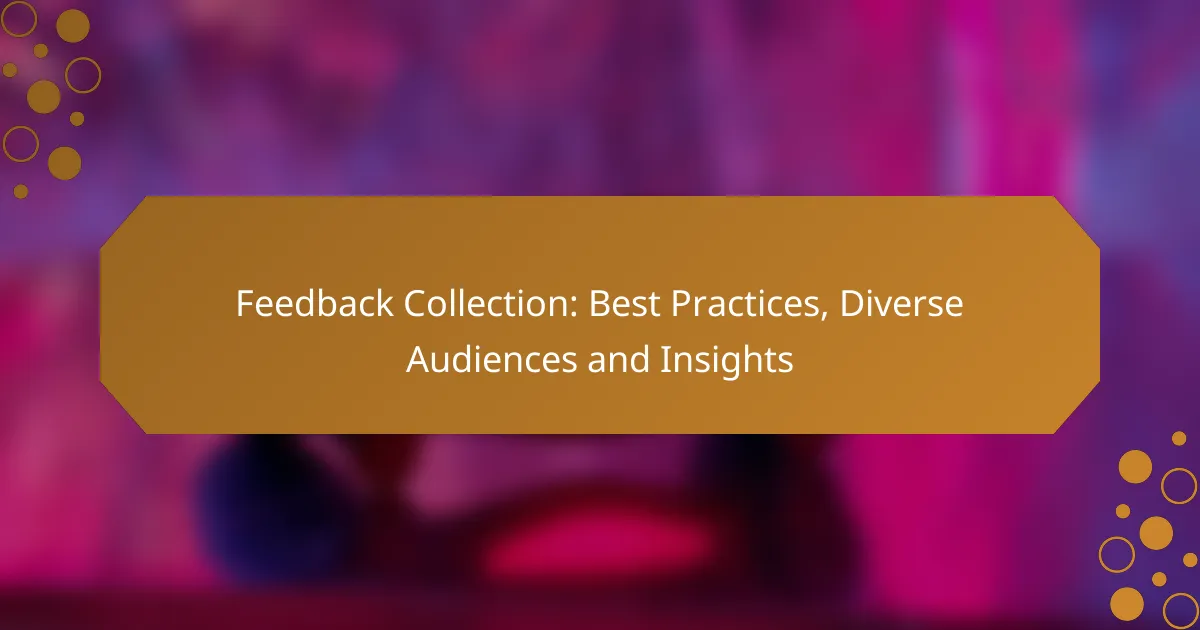Effective feedback collection is crucial for understanding user experiences and improving digital products. By leveraging user-friendly tools and adhering to best practices, businesses can gather actionable insights from diverse audiences. Tailoring feedback strategies to meet the unique needs of different groups ensures that the information collected is both relevant and valuable.

How can digital products enhance feedback collection?
Digital products can significantly improve feedback collection by providing efficient, user-friendly tools that facilitate real-time responses. These tools allow businesses to gather insights from diverse audiences, ensuring that feedback is actionable and relevant.
Utilizing survey tools like SurveyMonkey
Survey tools such as SurveyMonkey offer a structured way to collect feedback from users. They allow for customizable questions, enabling businesses to target specific areas of interest. Consider using a mix of multiple-choice and open-ended questions to gather both quantitative and qualitative data.
When designing surveys, keep them concise to encourage participation. Aim for completion times of under five minutes to maximize response rates. Additionally, consider incentivizing participation with small rewards, which can increase engagement.
Implementing feedback widgets in apps
Feedback widgets integrated within apps provide users with a seamless way to share their thoughts without leaving the platform. These widgets can be designed to pop up at strategic moments, such as after a purchase or a key interaction, to capture immediate reactions.
Ensure that the feedback process is straightforward. A simple thumbs-up or thumbs-down option, followed by a text box for comments, can yield valuable insights without overwhelming users. Regularly analyze the feedback collected through these widgets to identify trends and areas for improvement.
Leveraging social media platforms for insights
Social media platforms serve as powerful tools for gathering user feedback and insights. By monitoring comments, messages, and mentions, businesses can gain a real-time understanding of customer sentiment and preferences.
Engage with your audience by asking direct questions or creating polls on platforms like Twitter and Instagram. This not only fosters community interaction but also provides immediate feedback on products or services. Be sure to respond to comments and messages to show that you value user input, which can encourage more feedback in the future.

What are the best practices for collecting feedback?
Best practices for collecting feedback focus on clarity, honesty, and timing. Implementing these strategies can significantly enhance the quality and usefulness of the insights gathered from diverse audiences.
Crafting clear and concise questions
Clear and concise questions are essential for effective feedback collection. Use straightforward language and avoid jargon to ensure that respondents understand what is being asked. For example, instead of asking, “How do you perceive our service quality?” consider a more direct question like, “How satisfied are you with our service?”
Limit each question to one idea to avoid confusion. This approach helps respondents focus on their answers and provides you with more actionable insights. Aim for questions that can be answered in a few words or a simple rating scale.
Encouraging honest responses
To encourage honest responses, create a safe environment for feedback. Assure respondents that their answers will remain confidential and emphasize the importance of their input. For instance, you might include a statement like, “Your feedback is anonymous and will help us improve.”
Additionally, consider using open-ended questions that allow respondents to express their thoughts freely. This can lead to more genuine feedback compared to multiple-choice questions, which may limit their responses.
Timing feedback requests appropriately
Timing is crucial when requesting feedback. Ideally, ask for feedback shortly after an interaction or experience, as this increases the likelihood of receiving relevant and accurate responses. For example, sending a survey right after a customer service call can capture immediate impressions.
Avoid overwhelming respondents with too many requests at once. Space out your feedback requests to prevent survey fatigue and ensure that each request is meaningful. A good practice is to limit feedback requests to a few times per month, depending on the frequency of customer interactions.

How to tailor feedback collection for diverse audiences?
To effectively tailor feedback collection for diverse audiences, it’s essential to understand their unique needs and preferences. This involves adapting communication styles, utilizing various formats, and segmenting audiences to gather meaningful insights.
Adapting language for different demographics
Adapting language is crucial when collecting feedback from diverse demographics. Consider the age, cultural background, and education level of your audience. For instance, using simple language for younger audiences or technical jargon for industry professionals can enhance understanding and engagement.
Additionally, incorporating local dialects or colloquialisms can make respondents feel more comfortable and willing to share their thoughts. Always test your language choices with a small group to ensure clarity and appropriateness before wider distribution.
Using various formats for accessibility
Utilizing various formats ensures that feedback collection is accessible to everyone. Offer options such as online surveys, phone interviews, and in-person focus groups to cater to different preferences and abilities. For example, visually impaired individuals may benefit from audio surveys or screen reader-friendly formats.
Consider also providing materials in multiple languages or using visual aids to support comprehension. This approach not only broadens participation but also enriches the quality of feedback gathered.
Segmenting audiences for targeted insights
Segmenting audiences allows for more targeted insights during feedback collection. Identify key characteristics such as age, location, or user behavior to create distinct groups. This segmentation helps in tailoring questions that resonate with each audience, leading to more relevant and actionable feedback.
For example, you might segment respondents into categories like new users versus long-term customers. This distinction can reveal differing needs and preferences, enabling you to address specific concerns effectively. Regularly review and adjust your segments based on evolving audience dynamics to maintain relevance.

What tools are effective for feedback analysis?
Effective tools for feedback analysis help organizations gather, interpret, and act on user insights. Utilizing a combination of analytics, sentiment analysis, and customer relationship management (CRM) systems can provide a comprehensive view of user feedback.
Using Google Analytics for user behavior insights
Google Analytics is a powerful tool for understanding user behavior on your website. It tracks metrics such as page views, bounce rates, and user flow, allowing you to identify which areas of your site are performing well and which need improvement.
To maximize its effectiveness, set up goals and funnels that align with your feedback collection objectives. For example, if you want to increase newsletter sign-ups, track how many users complete the sign-up process and where they drop off.
Employing sentiment analysis tools like MonkeyLearn
Sentiment analysis tools, such as MonkeyLearn, analyze text data from user feedback to determine overall sentiment. These tools can categorize feedback as positive, negative, or neutral, providing quick insights into user perceptions.
When using sentiment analysis, ensure you have a diverse dataset to train the model effectively. Regularly update the model with new feedback to maintain accuracy. This approach can help you identify trends in user sentiment over time, guiding product or service improvements.
Integrating CRM systems for comprehensive data
Integrating a CRM system with your feedback analysis process allows for a holistic view of customer interactions. CRM systems can store feedback alongside customer profiles, enabling you to correlate feedback with specific demographics or purchase histories.
When setting up your CRM integration, focus on capturing key data points such as customer satisfaction scores and feedback sources. This information can help you tailor your marketing strategies and improve customer engagement by addressing specific needs and preferences.

What are the common challenges in feedback collection?
Feedback collection often faces challenges such as response bias, low response rates, and concerns about data privacy. Addressing these issues is crucial for obtaining accurate and actionable insights from diverse audiences.
Overcoming response bias
Response bias occurs when the feedback collected does not accurately represent the views of the entire audience. This can happen due to leading questions or the demographics of respondents skewing results. To mitigate this, use neutral language in surveys and ensure a diverse participant pool.
Consider employing randomized sampling techniques to reach a broader audience. Anonymity can also encourage honest responses, helping to reduce bias and improve the reliability of the data collected.
Dealing with low response rates
Low response rates are a common hurdle in feedback collection, often resulting from survey fatigue or lack of engagement. To enhance participation, keep surveys concise and relevant, ideally taking no more than 5-10 minutes to complete.
Incentives can significantly boost response rates. Offering small rewards, such as discounts or entries into a prize draw, can motivate participants to share their feedback. Additionally, sending reminders can help re-engage those who may have initially overlooked the survey.
Ensuring data privacy and compliance
Data privacy is a critical concern in feedback collection, especially with regulations like GDPR in Europe and CCPA in California. Organizations must ensure that they collect, store, and process feedback in compliance with these laws to protect respondents’ personal information.
Implementing clear privacy policies and obtaining explicit consent from participants can help build trust. Use secure data storage solutions and limit access to sensitive information to comply with legal requirements and maintain participant confidentiality.

How to measure the impact of feedback on product development?
Measuring the impact of feedback on product development involves assessing changes in user satisfaction, analyzing product usage trends, and collecting case studies that illustrate user experiences. These methods help determine how effectively feedback translates into product improvements and user engagement.
Tracking changes in user satisfaction metrics
To track changes in user satisfaction metrics, utilize surveys, Net Promoter Scores (NPS), and customer satisfaction scores (CSAT) before and after implementing feedback-driven changes. Regularly collecting this data allows for a clear comparison of user sentiment over time.
Consider setting benchmarks for satisfaction scores, aiming for improvements in the range of 5-10% after major updates. This can help gauge the effectiveness of the changes made based on user feedback.
Analyzing product usage before and after changes
Analyzing product usage involves examining key performance indicators (KPIs) such as user engagement, retention rates, and feature adoption rates before and after implementing feedback. Tools like Google Analytics or in-app analytics can provide insights into how users interact with your product.
Look for trends in user behavior, such as increased session duration or reduced churn rates, which may indicate that the changes positively impacted user experience. Aim for a noticeable shift in these metrics to validate the effectiveness of your feedback implementation.
Gathering case studies from user experiences
Gathering case studies from user experiences provides qualitative insights into how feedback has influenced product development. Reach out to users who have provided feedback and ask them to share their experiences with the changes made.
Document these case studies to highlight specific instances where user feedback led to significant improvements. This narrative approach can illustrate the real-world impact of product changes, making it easier to communicate value to stakeholders and guide future development efforts.


